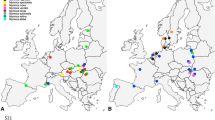Abstract.
Maculinea butterflies show social parasitism via obligatory myrmecophily as their larvae are adopted and raised to pupation by Myrmica ants. Suitable hosts differ for different Maculinea species, and host ant specificity can further differ at the population-level. Although early studies suggested single ant species as main hosts for each Maculinea species, it has recently become clear that their host ant specificity is more complex. Maculinea alcon and Maculinea ‘rebeli’ have variously been separated according to adult and larval morphology, phenology, and their use of different ecosystems, including host plant and host ant species. However, recent genetic evidence has questioned their separation as good species. Here we compare the use of host ants by M. alcon and M. ‘rebeli’ at the regional scale in NE-Hungary and Transylvania (Romania), where molecular studies have found no species-level separation between the two forms. We opened 778 nests of Myrmica ants and searched for Maculinea specimens (larvae, pupae and exuviae) shortly before imago emergence from the nest in seven M. alcon sites, six M. ‘rebeli’- sites and one site where both M. alcon and M. ‘rebeli’ are syntopic. In all, Maculinea caterpillars were found in the nests of seven different ant species (M. alcon was recorded mainly with Myrmica scabrinodis and occasionally with M. salina and M. vandeli; M. ‘rebeli’ used mainly M. scabrinodis, M. sabuleti and M. schencki and occasionally M. lonae and M. specioides). Myrmica scabrinodis was found to be a general host of both M. alcon and M. ‘rebeli’, which is the first record for a common host ant of these two closely related butterflies within the same region. However there were also differences in host ant use patterns between the sites occupied by the two Maculinea taxa, which reflect differences in Myrmica communities between the two types of habitat. Possible explanations for the similar but not identical host use patterns of M. alcon and M. ‘rebeli’, and their relevance for the question of whether they are separate species are discussed.
Similar content being viewed by others
Author information
Authors and Affiliations
Corresponding author
Additional information
Received 27 November 2007; revised 28 May 2008; accepted 11 June 2008.
Rights and permissions
About this article
Cite this article
Tartally, A., Nash, D.R., Lengyel, S. et al. Patterns of host ant use by sympatric populations of Maculinea alcon and M. ‘rebeli’ in the Carpathian Basin. Insect. Soc. 55, 370–381 (2008). https://doi.org/10.1007/s00040-008-1015-4
Published:
Issue Date:
DOI: https://doi.org/10.1007/s00040-008-1015-4




